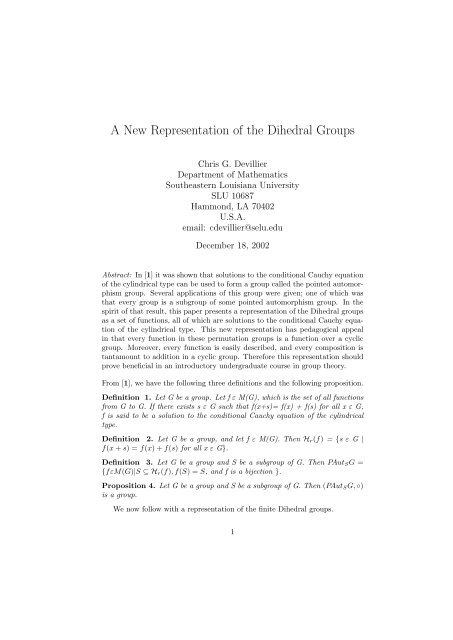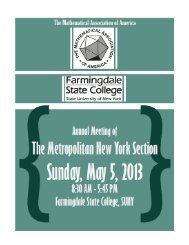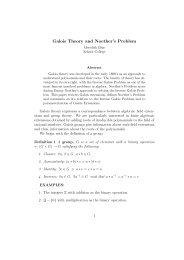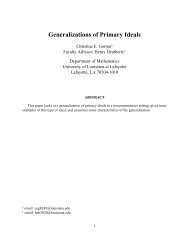A New Representation of the Dihedral Groups - MAA Sections
A New Representation of the Dihedral Groups - MAA Sections
A New Representation of the Dihedral Groups - MAA Sections
Create successful ePaper yourself
Turn your PDF publications into a flip-book with our unique Google optimized e-Paper software.
A <strong>New</strong> <strong>Representation</strong> <strong>of</strong> <strong>the</strong> <strong>Dihedral</strong> <strong>Groups</strong><br />
Chris G. Devillier<br />
Department <strong>of</strong> Ma<strong>the</strong>matics<br />
Sou<strong>the</strong>astern Louisiana University<br />
SLU 10687<br />
Hammond, LA 70402<br />
U.S.A.<br />
email: cdevillier@selu.edu<br />
December 18, 2002<br />
Abstract: In [1] it was shown that solutions to <strong>the</strong> conditional Cauchy equation<br />
<strong>of</strong> <strong>the</strong> cylindrical type can be used to form a group called <strong>the</strong> pointed automorphism<br />
group. Several applications <strong>of</strong> this group were given; one <strong>of</strong> which was<br />
that every group is a subgroup <strong>of</strong> some pointed automorphism group. In <strong>the</strong><br />
spirit <strong>of</strong> that result, this paper presents a representation <strong>of</strong> <strong>the</strong> <strong>Dihedral</strong> groups<br />
as a set <strong>of</strong> functions, all <strong>of</strong> which are solutions to <strong>the</strong> conditional Cauchy equation<br />
<strong>of</strong> <strong>the</strong> cylindrical type. This new representation has pedagogical appeal<br />
in that every function in <strong>the</strong>se permutation groups is a function over a cyclic<br />
group. Moreover, every function is easily described, and every composition is<br />
tantamount to addition in a cyclic group. Therefore this representation should<br />
prove beneficial in an introductory undergraduate course in group <strong>the</strong>ory.<br />
From [1], we have <strong>the</strong> following three definitions and <strong>the</strong> following proposition.<br />
Definition 1. Let G be a group. Let f ε M(G), which is <strong>the</strong> set <strong>of</strong> all functions<br />
from G to G. If <strong>the</strong>re exists s ε G such that f(x+s)= f(x) + f(s) for all x ε G,<br />
f is said to be a solution to <strong>the</strong> conditional Cauchy equation <strong>of</strong> <strong>the</strong> cylindrical<br />
type.<br />
Definition 2. Let G be a group, and let f ε M(G). Then H r (f) = {s ε G |<br />
f(x + s) = f(x) + f(s) for all x ε G}.<br />
Definition 3. Let G be a group and S be a subgroup <strong>of</strong> G. Then PAut S G =<br />
{fεM(G)|S ⊆ H r (f), f(S) = S, and f is a bijection }.<br />
Proposition 4. Let G be a group and S be a subgroup <strong>of</strong> G. Then (PAut S G, ◦)<br />
is a group.<br />
We now follow with a representation <strong>of</strong> <strong>the</strong> finite <strong>Dihedral</strong> groups.<br />
1
Proposition 5. Let n ≥ 2 be a natural number, let G = Z 2n , and let S be <strong>the</strong><br />
subgroup <strong>of</strong> Z 2n that is isomorphic to Z n . Define<br />
{<br />
x : x is even<br />
f(x) =<br />
x + 2 : x is odd<br />
and<br />
{<br />
g(x) =<br />
−x : x is even<br />
−x + 2 : x is odd.<br />
Then f, g ε PAut S G and for n > 2, 〈f, g〉 ∼ = D 2n .<br />
Pro<strong>of</strong>. In [2], we find that a non-Abelian group that is generated by two<br />
elements σ and τ where τ 2 = e and τστ = σ −1 is isomorphic to a <strong>Dihedral</strong><br />
group. Moreover, <strong>the</strong> order <strong>of</strong> <strong>the</strong> non-Abelian group is twice <strong>the</strong> order <strong>of</strong> σ.<br />
So we show that g 2 = e and that gfg = f −1 . First observe that<br />
{<br />
g 2 (x) =<br />
Therefore, g 2 = e.<br />
Next observe that<br />
{<br />
(gfgf)(x) =<br />
x : x is even<br />
−(−x + 2) + 2 : x is odd.<br />
−(−x) : x is even<br />
−[(−(x + 2) + 2) + 2] + 2 : x is odd.<br />
Therefore gfgf = e and hence, gfg = f −1 .<br />
To demonstrate that G is non-Abelian when n > 2, we have that<br />
{<br />
−x : x is even<br />
(fg)(x) =<br />
−x + 4 : x is odd<br />
and<br />
(gf)(x) =<br />
{ −x : x is even<br />
−x : x is odd.<br />
Thus if G ≠ Z 4 , <strong>the</strong>n 〈f, g〉 is a <strong>Dihedral</strong> group.<br />
If x is even, <strong>the</strong>n f m (x) = x for any positive integer m. If x is odd, <strong>the</strong>n<br />
f m (x) = x + (2m mod 2n) for any positive integer m. Therefore, |〈f〉| = n.<br />
Hence 〈f, g〉 ∼ = D 2n .<br />
Next we show that f, g ε PAut S G. First note that f and g are bijections.<br />
Also, since f and g are <strong>the</strong> identity on S, f(S) = S and g(S) = S. To show that<br />
S ⊆ H r (f), note that if x and s are both even, <strong>the</strong>n x + s is even; and we have<br />
that f(x) = x, f(s) = s, and f(x+s) = x+s. Therefore, f(x+s) = f(x)+f(s).<br />
If x is odd and s is even, <strong>the</strong>n x + s is odd; and <strong>the</strong>refore f(x + s) = x + s + 2 =<br />
x + 2 + s = f(x) + f(s). Thus S ⊆ H r (f). A similar argument proves that<br />
S ⊆ H r (g). Hence f,g ε PAut S G. So by Proposition 4, 〈f, g〉 is a group <strong>of</strong><br />
solutions to a conditional Cauchy equations <strong>of</strong> <strong>the</strong> cylindrical type.<br />
Remark: We know that for all x that are even and for any positive integer m,<br />
f m (x) = x and (f m g)(x) = −x. For x odd <strong>the</strong> elements <strong>of</strong> 〈f, g〉 are as follows:<br />
2
f(x) = x + 2, f 2 (x) = x + 4, f 3 (x) = x + 6, · · ·, f n−1 (x) = x + 2n − 2, f n (x) = x<br />
and<br />
g(x) = −x + 2, fg(x) = −x + 4, f 2 g(x) = −x + 6, · · ·, f n−2 g(x) = −x + 2n − 2,<br />
f n−1 g(x) = −x.<br />
Proposition 6. Let G = Z and let S = 2Z. Define<br />
{<br />
x : x is even<br />
f(x) =<br />
x + 2 : x is odd<br />
and<br />
{<br />
g(x) =<br />
Then f, g ε PAut S G and 〈f, g〉 ∼ = D ∞ .<br />
Pro<strong>of</strong>. From [1], 〈f, g〉 = PAut S G ∼ = D ∞ .<br />
−x : x is even<br />
−x + 2 : x is odd.<br />
Again observe that for x an even number, f(x) = x, gf m (x) = −x, and<br />
f m g(x) = −x. For x an odd number,<br />
f(x) = x + 2, f 2 (x) = x + 4, f 3 (x) = x + 6, · · · ,<br />
g(x) = −x + 2, fg(x) = −x + 4, f 2 g(x) = −x + 6, · · · , and<br />
gf(x) = −x, gf 2 (x) = −x − 2, gf 3 (x) = −x − 4, · · · .<br />
REFERENCES<br />
1. Devillier, C. Conditional Cauchy Equations and Applications, Aequationes Ma<strong>the</strong>maticae<br />
(to appear)<br />
2. Rose, J. A Course on Group Theory, Cambridge University Press, 1978.<br />
3
















